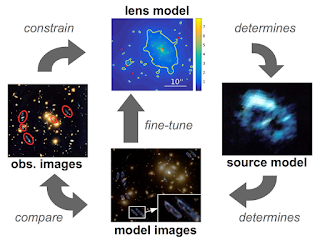Observations
Strong gravitational lenses as cosmic probes – "Lensing of '69"
Gravitational lensing is a very effective astrophysical phenomenon to probe the nature, distribution and agglomeration of dark matter in gravitationally bound objects because it only depends on the projected, two-dimensional mass distribution and is independent of any presuppositions about the luminosity, the composition, the state of equilibrium or the stability of the lensing object. If the total mass of a gravitational lens exceeds a certain threshold, it can map an extended background source to several highly distorted and magnified images. Analysing the properties of those images yields important information about the distribution of the lensing mass and the background source.
Common approaches to reconstruct the source or the lensing mass distribution model the global properties of the source and the lens. They obtain a consistent description of the entire configuration by refining the model until it matches the observation to a predefined precision.
This research project aims to free gravitational lensing from its conventional evaluation standards by developing a new approach to infer local properties of the gravitational lens [1, 2, 3, 4, 5] and to reconstruct the source using only the properties of the multiple images without assuming a lens or a source model.
To optimally extract the required properties of the multiple images, new methods for the segmentation of observational data and descriptors for the image shapes are investigated based on the so-called Irreducible Minkowski Structure Metrics.
To analyse the accuracy of the approach it is calibrated by simulations and compared to the results of model-based approaches on galaxy-cluster and on galaxy scale.
To investigate the relationship between various model-based approaches and our approach and to derive reasons why certain models are very good fits to observations, we develop a new approach to describe the morphology of gravitational lenses based on more fundamental principles (see Cosmic structures for further details).
Major advantages of the approach are:
- local lens properties are a unique solution of the system of equations set up by the strong lensing formalism for a single (effective) lens plane along the line of sight,
- local lens properties are the maximum information all lens-model-based lens reconstructions have in common and they are the maximum information retrievable without using a lens model,
- local lens properties can be efficiently determined in exactly the same way on multiple lensing scales and independent sets of local lens properties can be easily joined to a more global picture,
- source reconstructions only based on observables without any potential lens-model bias.
Applications:
- standalone local lens properties and inference of a dark-matter smoothness scale for gravitational lenses that have only very sparse observables available, e.g. Hamilton's Object,
- comparison of local lens properties from Lensing of '69 (e.g. using ptmatch) with model-based approaches (e.g. Grale, Lenstool, Lenstronomy, PixeLens) to test the validity of the lens-model assumptions in the vicinity of the multiple images, e.g. CL0024 or B0128,
- joint reconstruction of several multiple-image data sets to obtain a observation-based global lens reconstruction when highly dense observables become available, e.g. for James Webb Space Telescope surveys,
- studies of galaxies in the early universe free of potential lens-model biases.
This is joint work with many great people whom I want to thank for their continuous support and inspiring collaborations. To name a few: Richard Griffiths, Tim Hamilton, Jori Liesenborgs, Massimo Meneghetti, Johan Richard, Christian (Edi) Rusu, Prasenjit Saha, Paul L. Schechter, Peter Schneider, Dominique Sluse, Sherry Suyu, Nicolas Tessore, Liliya L. R. Williams, Adi Zitrin.
Supernovae as probes for cosmic distances
Looking back down our past light cone, extra-galactic cosmic distances cannot be uniquely determined, only redshifts are observed. Converting observed redshifts into cosmic distances is usually performed by assuming a specific cosmological model. Similarly to the lens models discussed above, the cosmological model in the distance measure is an additional assumption to turn an under-constrained equation into a solvable one. As data, supernovae type Ia are used to constrain the parameters of a cosmological model which serves as a fitting function in this case. The constituents of the cosmic expansion function can be inferred in this way.
Complementary to this approach, techniques have been established which set up a cosmic distance measure based on the standardised (calibrated) supernovae type Ia. This project contributes further to the extension of such techniques and investigates the reconstruction accuracy and precision of current supernova data sets in a mathematically rigorous way. Instead of a specific cosmological model, a general set of orthonormal basis functions is used to set up a cosmic distance measure. We focus on the selection of basis function sets that can be attributed a cosmological meaning and which have the tightest confidence bounds on the resulting cosmic expansion function.
The calibration of supernovae is subject to degeneracies like dividing the observed fluxes into a part caused by the propagation in a background cosmology and a part accounting for propagation effects caused by cosmic structures on top of the background, like magnification biases. To break these degeneracies and perform follow-up analyses of human biases in the calibration process, joint analyses of supernovae with other probes of cosmic distances are envisioned. Hopefully, fast radio bursts can contribute to solve the tensions currently arising in the calibrations of supernovae, the doubts raised for the standardisation of quasars, and the still large confidence bounds for gamma ray bursts.
In this project, I am very grateful to Yurij Baryshev, Eoin Ó. Colgáin, Suhail Dhawan, Mohamed Rameez, Subir Sarkar, Dan Scolnic, Arman Shafieloo, and Stanislav Shirokov for sharing their knowledge with me.
Fast radio bursts and plasma lensing
Fast radio bursts are highly energetic, extra-galactic radio signals which have only recently been discovered in significant amounts useful to probe cosmology. Having already proven useful to find the missing baryons in the universe, they are promising candidates to complement supernovae, quasars, and gamma ray bursts to set up an observational cosmic distance measure. In addition, being observed in the radio, they are highly valuable probes of plasma structures in order to better characterise the luminous matter contents of our universe. Knowledge transfer from gravitational lensing and the adaptation of Lensing of '69 to plasma lenses will shed further light into these hardly understood luminous structures.
In strong plasma lensing, degeneracies intrinsic in the lensing formalism for a single lens plane can be broken by the wavelength dependency of the plasma lensing effect, also called dispersion. For achromatic gravitational lensing, this is impossible. Gravitational lensing, however, has the advantage of a Poisson equation relating the local second-order lens properties into a more globally connected deflection potential. Plasma lensing is lacking a Poisson equation and therefore only constrains local lens properties. In addition, the dispersing propagation effects in plasma can destroy the signatures of the background source and it can be difficult to identify multiple bursts coming from the same source. Fast radio bursts as point-like sources may also yield an application of wave optics lensing and real-time cosmology.
The Fast Radio Burst community is also a very open-minded ground for investigating the role of human biases in discovery processes and data evaluation, which connects to my interests in the history and philosophy of science.
I would like to thank the entire Fast Radio Burst Community for their strong support, making me feel so welcome, and including many great colleagues who work and share their knowledge with me. To name a few: David Eichler, Ron Ekers, Xinzhong Er, Jason Hessels, Clancy James, Guoliang Li, Ue-Li Pen, Eran Ofek, Volker Perlick, Emily Petroff, Ziggy Pleunis, Laura Spitler, Shriharsh Tendulkar, Oleg Tsupko, and Artem Tuntsov.







